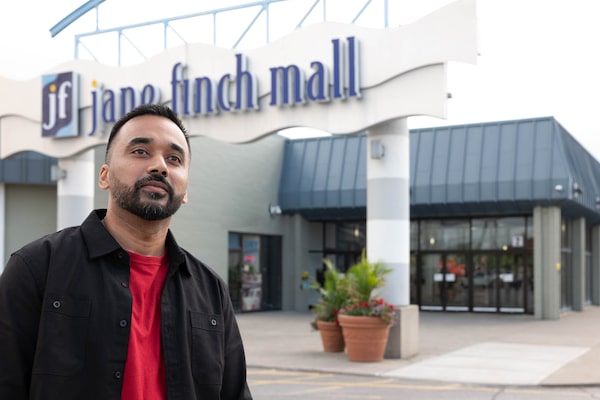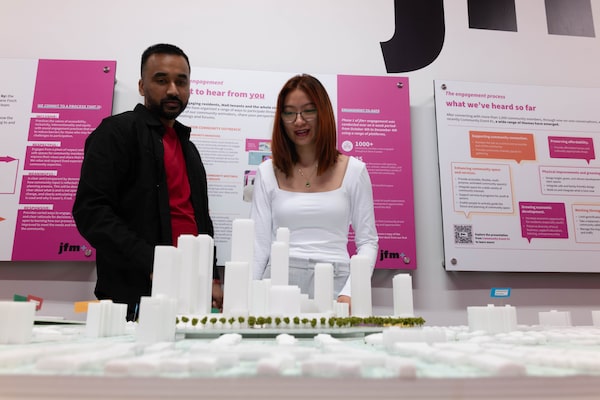
Troy Budhu, a resident in the Jane-Finch area in northwest Toronto, is part of a community advisory group that is working with developers on the future of the Jane Finch Mall’s development. 'It’s a gathering place,' he says of the landmark.Thomas Bollmann/The Globe and Mail
Change is coming to Toronto’s Jane and Finch neighbourhood, but the community has a message for the developers who own one of the area’s cornerstone shopping malls: make sure the mall is still in the picture.
So far, the developers, Brad-Jay Investments Ltd., appear to be listening, having consulted for the past several years with nearby residents through a formal process of meetings, interviews and public information, says Troy Budhu, an area resident who is part of a community advisory group set up to discuss the site’s future.
“I called for setting up this advisory group when the plans were all about gentrification. The developer needed to have conversations with residents,” says Mr. Budhu, who is currently completing an MBA in community economic development at nearby York University.
“It’s a gathering place,” Mr. Budhu says of the Jane Finch Mall, located at the southeastern corner of Jane Street and Finch Avenue West since 1968. The mall, one of several at the same intersection, is a magnet for many in the community, which is highly diverse and includes many newcomers to Canada.
The neighbourhood, including the Jane Finch Mall property, is slated to be transformed by new housing, commercial and retail development after the completion of the city’s new Finch Ave. LRT (rapid transit line), expected to be operational in the first half of 2024.
With a major infrastructure boost on the way, the developers had many options for the Jane Finch Mall site.
According to Jay Feldman, co-owner of the mall and president of Brad-Jay, they could have drawn up plans to demolish the shopping centre and replace it with condos, offices and new retail, but decided to take a different direction.
“We could see that with new rapid transit stops at either end of the mall, change will be coming. We decided to start the process of change with community consultation,” says Mr. Feldman, who is also president of RiverPoint Consulting Inc., which advises high-net-worth families.
“What’s there now is a classic shopping centre, anchored by a grocery store, with 230,000 square feet of leasable area and most of the property taken up by a parking lot,” he says. “We engaged 12 people who live and work in the community to be ‘animators’ and go out and talk to people and see what they want for the future.”
It takes some imagination to understand what a mall can mean to a community and sometimes you have to do something different, but you don’t always have to reinvent the wheel.
— Elspeth Murray, associate professor of entrepreneurship and strategy, Smith School of Business, Queen’s University
Emily Reisman, partner at Urban Strategies, a planning and design firm that works with both private and public sector developers, says her company approached community leaders “about three years ago [on Brad-Jay’s behalf] and asked them how to get peoples’ views.”
This led to a more formal consultation process known as jfm+, which has connected 2,000-plus residents over three years, through one-on-one conversations with neighbours as well as walking tours, working group sessions, online meetings and behind-the-scenes open-door visits to the mall.
“We tried to meet people where they are, go to them. The public engagement started during COVID, so we had to start with online meetings. Later we moved to small groups and then we opened a storefront in the mall where we could share ideas and listen. It’s still there,” Ms. Reisman says.
“The main point we learned from the community is that the mall is important to peoples’ everyday lives. We want that point to come through in all elements of our plan,” Mr. Feldman says.

Troy Budhu, left, and Christine Le look over a model of the mixed-use development plan for the Jane-Finch area in the office of jfm+, which has connected with more than 2,000 community members over the past three years.Thomas Bollmann/The Globe and Mail
In August, 2023, the mall owners submitted their planning application to the City of Toronto, but the final designs for the site are still evolving, based largely on what community members are saying about what they want.
The go-slow approach is refreshing, says Elspeth Murray, associate professor of entrepreneurship and strategy at Queen’s University’s Smith School of Business in Kingston, Ont.
“Mall owners are learning that it pays to be enlightened. If you believe that success goes beyond short-term financial returns, it can pay off better over the longer term,” she says.
“It takes some imagination to understand what a mall can mean to a community and sometimes you have to do something different, but you don’t always have to reinvent the wheel,” she says.
Mr. Feldman agrees that, according to community feedback, the Jane Finch Mall is unlike many dead and dying malls in urban areas across North America. The first phase of the property’s redevelopment is expected to take about 10 years.
“This mall is thriving. We’re developing around it, with the mall at the centre,” Mr. Feldman says. Even with the planning application already submitted, the final form of the redevelopment will continue to evolve, he adds.
Plans include a mix of housing, including affordable units (based on City of Toronto guidelines), offices and retail.
There will also be new indoor public space within the development, with programming handled by the community, as well as a large outdoor gathering space about the size of the one-acre Yonge-Dundas Square, he says.
Mr. Budhu notes that the project planners have been taking into account what neighbourhood residents are saying.
“For example, originally there was the idea to add extra storeys to the mall, but people didn’t like that,” he says.
“We are people who live in the area and shop in the mall,” says Christine Le, one of the animators, who also is a resident in the Jane and Finch area and works in the storefront community information centre set up in the mall by its owners.
“I know that when the LRT comes it’s going to be a game changer. People who have to travel for hours to get from here to work will be able to go across town fast, and more people from other parts of the city will come here,” she adds.
Residents are also concerned that the new transit will hike up land prices and put the neighbourhood out of reach.
“It will be different. But we want to be able to go to mom-and-pop shops run by people we know. We still need to be within walking distance to reach our essential services – whether it’s for things like job training or for groceries,” Ms. Le says.
“The mall is our place and it’s still important to us.”